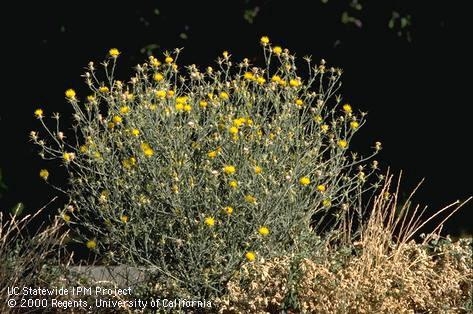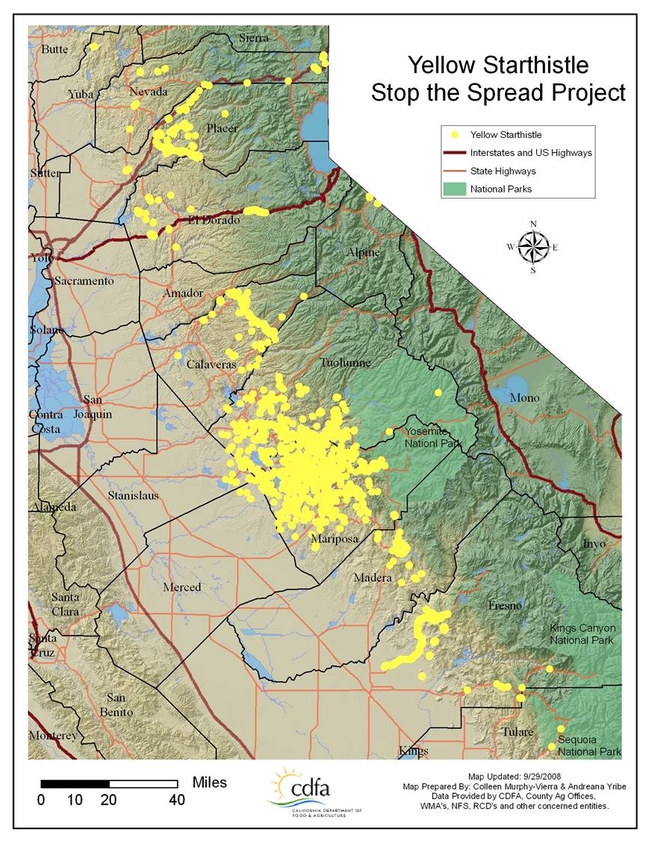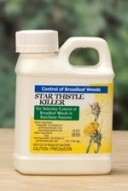Time to plan your yellow starthistle weed attack
Weeds, weeds, weeds! Have you noticed? This has been a banner year for weeds. Puncturevine where I’ve never seen it before. Garden soil covered with common purslane (at least it’s good in salads). And solid stands of yellow starthistle everywhere!
Our cool late spring and repeated late rains created multiple germination periods; weed seeds in the soil had many opportunities to sprout. And sprout they did! With the heat of summer, weeds flowered and became noticeable. Now, weeds have set seed and dried along roadsides, in fields, and landscapes. All those weed seeds will require diligent effort next spring! It’s time to plan your weed attack to prevent next year’s seedlings.
What can be done? First of all, identify your weeds. Different weeds require different treatments. Is it an annual or perennial? Does it propagate by wind-blown seeds or by runners? The University of California Integrated Pest Management website, has weed-identification guides that are fun and easy to use. The website also offers treatment guidelines.
In the California foothills, yellow starthistle (YST) is perhaps the most common weed of concern. It impacts much of our open space - agricultural and rangeland - and intrudes into our neighborhood landscapes. Yellow starthistle currently infests more than 15 million acres of land in California. Not only does it prevent recreational use, like walking or hiking, but it chokes out native grasses and wildflowers. It is also poisonous to horses, causing a neurological disorder called "chewing disease” which can be fatal once symptoms develop.
More and more, individual homeowners are becoming the key to containing and eliminating this invasive plant, wherever it exists. The goal in treating yellow starthistle is to prevent seed formation. Unfortunately, this year's YST has already bloomed, set seed, and dried. Planning is essential to prevent another banner crop next year.
That said, yellow starthistle can be hand-pulled at any time in its lifespan. In its present dry and spiny stage, pulling the weeds can inflict pain, so be sure to wear gloves. Double-bag the plants and burn them later in the fall.
There is a fairly new herbicide (2009) on the market from Monterey Chemical called Star Thistle Killer.
It is available at home centers and nurseries and can be purchased without a permit. The active ingredient, clopyralid, is the same active ingredient in Transline and should not be used on lawns. However, one spray application on small parcels of less than two acres during the late fall, winter, or early spring rainy season will be effective in preventing yellow starthistle seedling germination next spring.Local pest control companies are also available to provide a one-time herbicide application for yellow starthistle. For more information, go to the Central Sierra Cooperative Extension website or call the Yellow Starthistle Leading Edge Project in the UC Cooperative Extension office at (530) 621-5533 or (209) 533-6993.
Information adapted from the University of California Integrated Pest Management Program and from “Yellow Starthistle: Brief Homeowner Information Sheet” by John E. Otto, Amador County Master Gardener.
Also see the following video on yellow starthistle control.
YST Homeowner Handout
RebeccaYST




